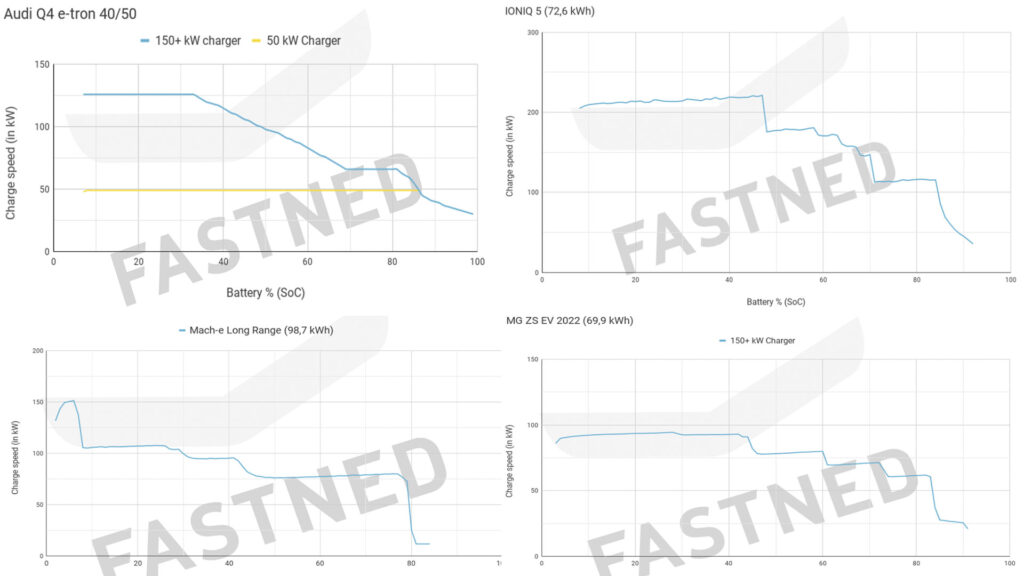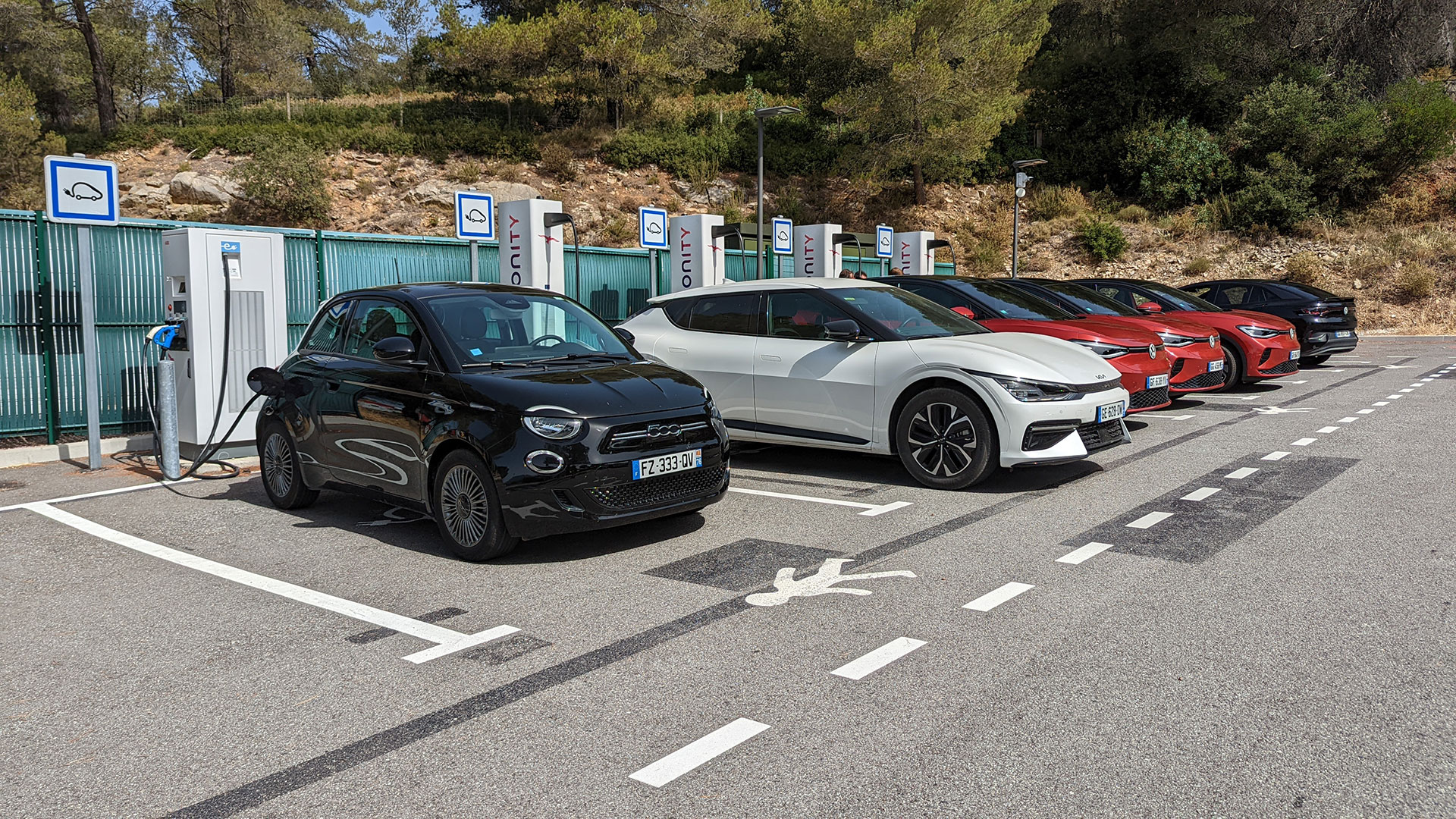Habits die hard: some electromobilists are still trying to “refuel” at fast charging stations. However, this is a counterproductive idea, which can create unnecessary expectations for other electric vehicles, especially during major departures.
It sounds crazy to say, but doing 3 well-optimized recharging stops, instead of 2 while trying to refuel, often saves more time on the total trip. With the departures on vacation, it is easy to observe that many motorists driving on electric do not yet master how to optimize their charging on long journeys. Many seek to consistently top up the battery to 100%, or close to that value. This method can waste them time or money (depending on charging station pricing), in addition to creating unnecessary waits at the charging station.
Tesla owners have already gotten into the habit of only charging what’s needed to continue their journey, greatly aided by their car’s scheduler. For the others, there is certainly a lack of training in car delivery, combined with a fear of breakdowns. This attitude, however, puzzles users who are more experienced in the exercise, especially since there is no longer a lack of charging stations on the motorways.
Charging time sometimes doubled
In some cases, 100% charging on the motorway is legitimate, for example for a vehicle towing a trailer, because its consumption will be much higher. Let’s avoid any misunderstanding: we’re not telling you not to do it, or that it’s bad for your battery if you do it for specific needs. It’s just that it’s now inappropriate and time-consuming. In the majority of cases, an 80% charge is enough to calmly continue your journey until the next charging session. The network of charging stations makes it possible to travel more and more serenely over long distances.
It often takes as long to fill the battery from 20 to 80% as it takes to fill the last 20%. The closer you get to 100%, the longer the duration can lengthen until it seems endless, even on a terminal that is supposed to be fast. Moreover, this always creates some misunderstandings, it is not the flow rate of the charging station which is suddenly bad in this situation, but it is what the electronics of your car accept to spare the chemistry of the battery. The last electrons that we put in the battery are a bit like the last drops that we put in the tank after the “click” of the fuel nozzle.
If the concept of charging curve is mastered by the owners of the seasoned electric vehicles, for some novices, this concept is completely unknown, because never presented to the buyer. This sometimes pushes you to adopt somewhat surprising behaviors, such as stopping to charge when you have 70% battery remaining. It will take much longer to recharge these possible 30%, than to do it once the battery is at 30% of its capacity, or less.
But what is the charging curve?
The charging curve is the power flow theoretically accepted by the battery, depending on its level of charge (Soc). It is specific to each electric vehicle and depends on the choices made by the vehicle manufacturer.
For the brand, the idea is to find the best compromise between recharging speed and battery cell durability. The recharging power can be deliberately restricted by the care of the manufacturer, to prevent the cells from overheating during charging. This sometimes explains why, following a vehicle software update, a car may see its charging speed increase or decrease, even though there has been no physical change to an attached part. to the battery.
However, the charging curves almost all have one thing in common: their drop is often dizzying the closer you get to 100%.

It would probably be useful for manufacturers, who communicate more easily on the maximum charging powers, to also indicate the charging curve that accompanies the vehicle. This would surely allow customers to better understand why the charging station, given to have a flow rate of 350 kW, only distributes to their vehicle a maximum of 70 kW before collapsing to 15 kW.
The fast charging operator Fastned has published the charging curves of many vehicles in circulation in the FAQ on its website. The Automobile-Propre website also distributes a charging time simulator also representing these charging curves.
For more electrical efficiency, the chip jump method is used
The chip-hopping method is all about making the most of your car’s charging capabilities. Shorter breaks, never exceeding 70 or 80% battery, and waiting to have a sufficiently low autonomy for the car to recharge faster on the terminal according to its charging curve. So, depending on your model, 3 breaks of 20 to 30 minutes can sometimes charge the same kWh capacity as 2 breaks of 45 to 1 hour. When you start in electric, you are often too careful, but by knowing your vehicle better, you can save time on recharging, even if it means occasionally flirting with 0%.
Let’s not forget that every two hours, the break is essential! That’s good, it generally corresponds to the moment when a charge can be welcome for a good part of the electric cars equipped with a large battery. For models with batteries more suitable for urban use, the breaks may be more like every 1h30, especially if you are driving on the highway at a speed of 130 km/h. This of course depends on the consumption of your model, the weather conditions and the capacity of the battery.
If this method was still difficult to use serenely a few years ago, especially outside the networks of Tesla superchargers, the network of fast charging stations is now more developed to do so. If your vehicle does not have a trip planner, the Chargemap, ABRP or Chargefinder applications can help you prepare your trip and find free charging stations.
To optimize the break time, and if the vehicle has this possibility, do not hesitate to activate the preheating of the battery. A battery that is not at the ideal temperature (too hot or too cold) when charging will see its recharging power greatly reduced in its possibilities. Again, it’s a waste of time.
By avoiding needlessly occupying a terminal beyond what is necessary, recharging on long journeys can only go better for everyone. Unfortunately, there will always be the problem of the reliability of the terminals, which may find themselves with a limited flow or worse, completely out of service.
Subscribe to Numerama on Google News to not miss any news!
